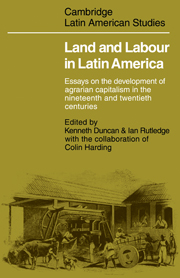 Land and Labour in Latin America
Land and Labour in Latin America Published online by Cambridge University Press: 07 May 2010
The period from the 1880s to the 1920s was the ‘Golden Age’ of coffee in western São Paulo. Santos, Sao Paulo's only major port, had replaced Rio de Janeiro as the world's most important coffee export centre by 1894. Santos’ share of the world coffee market rose from less than 25 per cent in the late 1880s to 50 per cent by the first years of the twentieth century, and it continued to supply more than half the world's coffee until after the First World War. In absolute terms the annual production of the Santos coffee zone increased from an average of under two million bags during the last years of slavery to more than eight million bags in the first five years of this century, and continued at high levels thereafter. The transition from slave to free labour, the rapid expansion of coffee cultivation, and massive European immigration into Sao Paulo characterize the period here under examination – the four decades from the decline of slavery in the 1880s to the Great Depression.
The geographical area being considered is the coffee region which exported its production through the port of Santos – that is, the interior plateau west and north of the city of São Paulo. The section of the Paraíba River Valley in eastern São Paulo, together with the coffee areas of southern Minas Gerais and Rio de Janeiro state, exported through the port of Rio de Janeiro. The coffee boom in the Paraiba Valley preceded that of the western plateau and was characterized by the slave labour system.
To save this book to your Kindle, first ensure no-reply@cambridge.org is added to your Approved Personal Document E-mail List under your Personal Document Settings on the Manage Your Content and Devices page of your Amazon account. Then enter the ‘name’ part of your Kindle email address below. Find out more about saving to your Kindle.
Note you can select to save to either the @free.kindle.com or @kindle.com variations. ‘@free.kindle.com’ emails are free but can only be saved to your device when it is connected to wi-fi. ‘@kindle.com’ emails can be delivered even when you are not connected to wi-fi, but note that service fees apply.
Find out more about the Kindle Personal Document Service.
To save content items to your account, please confirm that you agree to abide by our usage policies. If this is the first time you use this feature, you will be asked to authorise Cambridge Core to connect with your account. Find out more about saving content to Dropbox.
To save content items to your account, please confirm that you agree to abide by our usage policies. If this is the first time you use this feature, you will be asked to authorise Cambridge Core to connect with your account. Find out more about saving content to Google Drive.